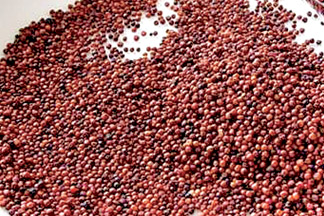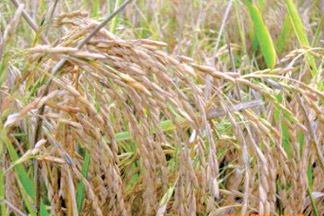|
Kurakkan and rice flour:
It pays to enrich your bread
By Nilma Dole
 Bread is believed to be the basic food that supports life. However,
with imported wheat flour and other chemicals going into the locally
produced bread, is it still healthy for consumption? Bread is believed to be the basic food that supports life. However,
with imported wheat flour and other chemicals going into the locally
produced bread, is it still healthy for consumption?
Taxing imported bread and wheat flour-based products to encourage the
purchase of locally-made bread, has made people worry if the local flour
products will be just as nutritious and energy-giving as the white
bread.
A study was conducted by the Ruhunu University's Food Science and
Technology Department (Faculty of Agriculture) recently on the
importance of improving the nutritional quality of traditional bread
using locally-made flour.
The objectives of the study were to find out whether rice flour could
be substituted for wheat flour, and the best combination of rice flour,
kurakkan and wheat flour that can be used in preparing bread.
The Sunday Observer interviewed Buddhika Perumpuli of the Ruhunu
University who conducted the study to determine whether rice flour and
kurakkan is advantageous over wheat flour, on nutrition, value and
price.
 Q: Why did you decide to research and find out whether rice
flour can be substituted for wheat flour? Q: Why did you decide to research and find out whether rice
flour can be substituted for wheat flour?
A: Nowadays, junk food is popular the world over and the
situation is the same in Sri Lanka too. Most of the foods are based on
milled wheat flour which is less nutritious.
Due to this the risk of diabetes, obesity and other health defects
have increased.
When we compared wheat flour and rice flour, the glycemic index of
wheat flour is comparatively higher than rice flour where it raises the
blood glucose level quickly. Also, when compared to rice flour, wheat
flour is low in dietary fibre.
Due to these reasons, we thought it beneficial to substitute wheat
flour with rice flour in bakery products. Since we don't grow wheat, the
flour is imported, whereas rice is nationally produced. So, we believe
that researching on the ability to substitute wheat flour with rice
flour would help the local farmers and obviously the national economy.
We should highlight the importance of gluten which maintains the
texture of bread. In comparison to wheat flour, rice flour is low in
gluten. Thus, rice flour alone cannot be used in baking bread and other
products. If we use rice flour only, we have to add gluten externally
which will increase production cost. In that case, we can substitute
rice flour only up to a certain level without damaging the texture and
structure of the bread. In our laboratory, we have researched on rice
flour incorporated in bread, cake and biscuit too.
Q: Why is it important to improve the nutritional value of
bread?
 A: In Sri Lanka, bread is totally produced with wheat flour
and we use wheat flour with a low extraction rate which is around 74
percent. A: In Sri Lanka, bread is totally produced with wheat flour
and we use wheat flour with a low extraction rate which is around 74
percent.
However, the extraction rate of wheat flour used in other countries
is higher. Extraction rate means the proportion of grain in the flour.
During milling process, the outer layers of the grain and the
wheatgerm are removed. Beneath the outer coverings, the aleurone layer,
rich in vitamin B and proteins is present.
The germ is a rich source of nutrient that contains protein, vitamin
B, vitamin E and thiamin. So, what we obtain as wheat flour is just
starch and poor in nutritional value. Thus, it is important to improve
the nutritional value of bread.
Q: In what way is kurakkan flour a good substitute for wheat
flour?
A: Kurakkan flour also can be used as a substitute for wheat
flour. But due to the poor gluten content, its unique appearance and
taste, it cannot be solely used in the bakery industry. In another
research, we tried to develop a nutritionally rich bread by combining
wheat, rice and kurakkan flour, which was also successful.
Q: The Friedman test was used for these experiments. Why?
A: The Friedman test is a statistic analysis method which we
use for non-parametric data such as preference. During sensory
evaluation, we evaluated the preference of the panel members for our
developed product. Usually, they give us a rank for every sensory
attribute and only then will the data be analysed.
Q: Doctors and nutritionists say kurakkan flour is better than
wheat flour due to health benefits but people still do not heed the
advice. From your findings why would you say this is correct?
A: Kurakkan flour is good for health as it contains high
amounts of fibre, B-complex vitamins including niacin, thiamin, and
riboflavin, the essential amino acid methionine, lecithin, and some
Vitamin E. It is particularly high in minerals such as iron, magnesium,
phosphorous, and potassium.
The seeds are also rich in phytochemicals, including phytic acid,
believed to lower cholesterol, and phytate, which is associated with
reduced cancer. Methionine (essential amino acid) is limited in
communities which consume rice, yams and tubers and is rich in kurakkan.
 As the fibre content is high, there is a feeling of fullness and
satiation after consumption and this prevents snacking and eating in
between meals. It is also low in fat, containing about 1.7 grams in
every 100g. As the fibre content is high, there is a feeling of fullness and
satiation after consumption and this prevents snacking and eating in
between meals. It is also low in fat, containing about 1.7 grams in
every 100g.
Kurakkan flour is categorised into median glycemic index foods which
release glucose into the blood stream slowly which is an advantage for
diabetics.
The main reason for the low consumption of this food is due to the
attitude of people. People refer to this crop as "coarse grain" or "the
poor man's crop". The nutritional advantage of it has not been
understood.
Also, kurakkan can be prepared in dishes such as roti and thalapa.
Today, there are products that use kurakkan such as bread and noodles,
but are not popular due to the appearance and taste. It is important to
educate consumers on the health benefits of kurakkan.
Q: What have your findings shown?
A: According to our findings, bread can be produced by
incorporating rice flour up to 20 percent (i.e. 80 percent wheat flour
and 20 percent rice flour). We tried to provide bread using wheat, rice
and kurakkan flour. In the research, we used 80 percent wheat flour and
20 percent rice flour as the base level and incorporated kurakkan flour
in different ratios.
According to both sensory and nutritional analysis, 80 percent wheat
flour and 15 percent rice flour and 5 percent kurakkan flour is the best
combination. This bread experiment is rich in protein, fat and fibre as
compared to the 100 percent wheat flour bread and the 80 percent wheat
flour and 20 percent rice flour combination.
Q: If rice flour can be incorporated into bread-making, do you
think Sri Lanka will find it difficult to meet the demand?
A: If we tried to make rice incorporated bread, the demand for
rice will increase and import of wheat could be reduced. Farmers will
get an opportunity to sell their products at a good price. This will
enhance rice production in the country and farmers are encouraged under
this situation.
According to our findings, we can incorporate rice flour up to 20
percent without affecting the sensory attributes and achieving this
value will not be difficult.
Q: What advice would you give consumers and bakers about
replacing wheat flour with rice flour and kurakkan?
A: Due to busy lifestyles, most people are used to eating junk
food. Such food products are produced using wheat flour which is less in
nutrition. As a result, diseases like type 2 diabetes, colon disease,
obesity (and obesity-related diseases) are rampant.
When compared with wheat flour, rice flour and kurakkan is a rich
source of fibre and vitamins. Thus, if we tried to replace wheat flour
with rice flour, we could avoid the occurrence of such diseases.
|


